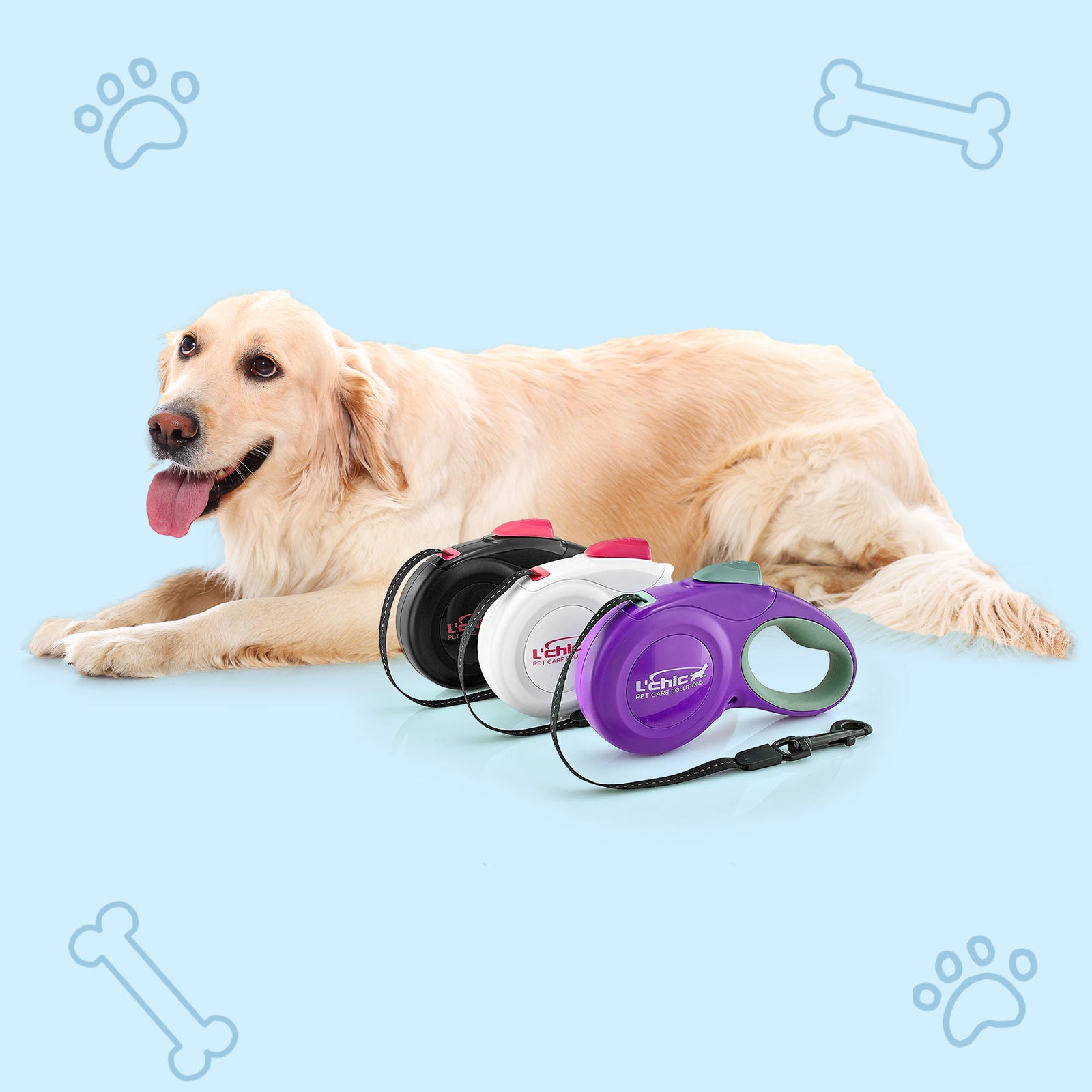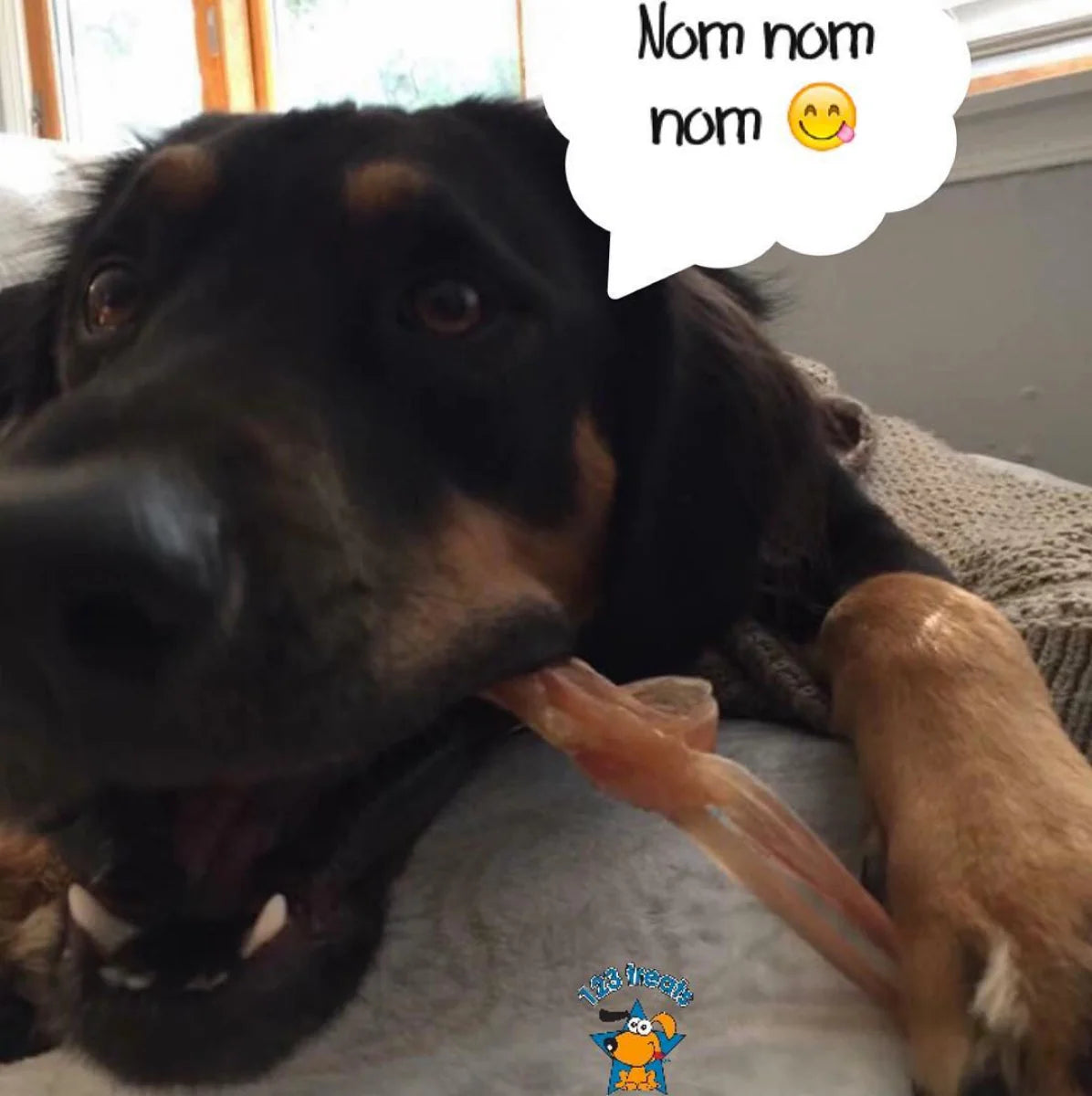Pet Toys & Supplies
Paws Up for Playtime! Discover Toys That Keep Tails Wagging.

Shop all Toys
Caring for Your Pet, Simplified – Quality Supplies for Every Pet Parent!

Shop all Pet Supplies
HOW AND WHEN TO GIVE HEALTHY DOG TREATS
September 06, 2010 4 min read

Positive reinforcement is a powerful tool for training your pet. Dogs, like people, respond to two motivators; pleasure and the avoidance of displeasure. While there are several techniques for rewarding desirable behavior, food treats are a favorite for both dogs and their owners. Many of us give treats as a gesture of affection, but they can also be used as an important component in training your dog.
Food treats make the training more enjoyable for the dog and creates a bond between them and the trainer. Dog treats are extremely effective for training because dogs have an enormously keen sense of smell. They can detect the scent of food from more than 20 yards away. There are a variety of treats available, but it’s important to choose treats your dog likes and that are healthy. Below, we discuss the types of treats that are best for your dog and when they should be given.
The Most Effective Way to Use Dog Treats
Before using a treat for training, it’s best to let your dog sample it first. Your dog may not like certain treats, or he may decide he’d rather play with it than eat it. Treats should be used to encourage obedient behavior. Avoid rewarding your dog for over-zealous behavior. Often times, when your dog smells the treat, he will grow excited and may even pounce on you. Since he can smell the treat from a good distance, you don’t need to place it beneath his nose. Wait for the dog to calm down before giving him the treat. Indicate your disapproval by moving away or through other body language.
It may take some time, but eventually your dog will begin to understand the behavior he needs to exhibit to be rewarded with the treat. He will learn to sit quietly and watch you. When he is calm and waiting patiently, give him the treat. Always use treats to reward desirable behavior.
The Best Time to Give Treats
The best time to give treats is midway between meals. Your dog won’t respond as well to treats during training if they have recently been fed. There are many different types of treats available. You can choose several varieties and determine which ones your dog likes best. Save the treats they like best for last. They can help motivate your dog if he should lose interest while training. If you routinely feed your dog following a training session, you may want to change the feeding schedule. If the dog knows he will be fed immediately after training, he may be less likely to respond to treats.
A good method for giving your dog treats is to enclose it in your hand between the thumb and first two fingers. Allow your dog to sniff the treat so that he knows it's there. While he is sniffing, slowly raise it over his head and somewhat behind the shoulders. The goal is to have your dog lift his head and shift the shoulders to encourage him to place his rear on the floor.
Raise the treat gradually, allowing the dog’s nose to follow. If he jumps for the treat, move it away. On the next attempt, position the treat closer to the head. When he follows the treat with his nose and positions his rear on the floor, with a relaxed tone, say “sit”, and let him have the treat. It’s important to speak in a calm voice. A harsh tone may startle or distract your dog so that he doesn’t learn the lesson. Use small treats so that your dog will eat them quickly, and you can move on with the training.
When you first begin training, it’s important to give your dog a treat immediately when he performs the desired behavior. Once your dog has reliably learned the behavior, you can gradually reduce the number of times he is given a treat. You should continue to reinforce the positive behavior with praise. Don’t decrease the number of rewards too quickly, but slowly change to an intermittent method of rewarding him.
Choosing Healthy Dog Treats
In addition to choosing healthy treats, you should also provide treats that your dog enjoys. Dogs have different nutritional needs than humans, and their sense of taste is also different. Like many foods for humans, dog treats may contain artificial ingredients. Natural dog treats are often a healthier choice. There are some foods you should avoid giving dogs entirely. Chocolate, grapes, raisins, and onions are toxic to dogs.
The three most common treats for dogs are biscuits or cookies, bones and animal based chews. Dog biscuits can be found in everything from milk bone biscuits to gourmet dog cookies. You should never give dogs cooked poultry bones, but large, sturdy beef bones can provide an excellent treat. You can ask for them at the meat department of your grocer or your butcher. Bones are messy so they are best given outside.
Animal based chews often consist of rawhide, pig ears or cattle hooves. It’s best to determine your dog’s chewing style before selecting animal chews. Large knots and rawhide are most appropriate for hearty chewers. Make sure your dog doesn’t swallow any large chunks. The treats should be discarded once they are worn to prevent your dog from swallowing large chunks.
Consult Your Vet or Specialty Pet store
A veterinarian is the most valuable resource you have for choosing the proper nutrition for your dog. They are most familiar with your dog’s health and can advise you on treats that will best suit the needs of your dog based on his size, age and breed. Some treats contain nutrients that promote the health of your dog’s teeth, eyesight or other organs. A veterinarian will know which are the most effective and beneficial for your dog. Representatives in specialty pet stores can also be helpful. Most are familiar with the quality and nutritional value of pet products and can offer suggestions for the appropriate treat for your dog.
Proper Use of Treats
Many of us tend to give our dogs treats to show affection. If you’re using treats as a part of their training, this may cause confusion for your dog. To reinforce desired behavior, it is important to be consistent in the use of treats.
Positive reinforcement is a powerful tool for training your pet. Dogs, like people, respond to two motivators; pleasure and the avoidance of displeasure. While there are several techniques for rewarding desirable behavior, food treats are a favorite for both dogs and their owners. Many of us give treats as a gesture of affection, but they can also be used as an important component in training your dog.
Food treats make the training more enjoyable for the dog and creates a bond between them and the trainer. Dog treats are extremely effective for training because dogs have an enormously keen sense of smell. They can detect the scent of food from more than 20 yards away. There are a variety of treats available, but it’s important to choose treats your dog likes and that are healthy. Below, we discuss the types of treats that are best for your dog and when they should be given.
The Most Effective Way to Use Dog Treats
Before using a treat for training, it’s best to let your dog sample it first. Your dog may not like certain treats, or he may decide he’d rather play with it than eat it. Treats should be used to encourage obedient behavior. Avoid rewarding your dog for over-zealous behavior. Often times, when your dog smells the treat, he will grow excited and may even pounce on you. Since he can smell the treat from a good distance, you don’t need to place it beneath his nose. Wait for the dog to calm down before giving him the treat. Indicate your disapproval by moving away or through other body language.
It may take some time, but eventually your dog will begin to understand the behavior he needs to exhibit to be rewarded with the treat. He will learn to sit quietly and watch you. When he is calm and waiting patiently, give him the treat. Always use treats to reward desirable behavior.
The Best Time to Give Treats
The best time to give treats is midway between meals. Your dog won’t respond as well to treats during training if they have recently been fed. There are many different types of treats available. You can choose several varieties and determine which ones your dog likes best. Save the treats they like best for last. They can help motivate your dog if he should lose interest while training. If you routinely feed your dog following a training session, you may want to change the feeding schedule. If the dog knows he will be fed immediately after training, he may be less likely to respond to treats.
A good method for giving your dog treats is to enclose it in your hand between the thumb and first two fingers. Allow your dog to sniff the treat so that he knows it's there. While he is sniffing, slowly raise it over his head and somewhat behind the shoulders. The goal is to have your dog lift his head and shift the shoulders to encourage him to place his rear on the floor.
Raise the treat gradually, allowing the dog’s nose to follow. If he jumps for the treat, move it away. On the next attempt, position the treat closer to the head. When he follows the treat with his nose and positions his rear on the floor, with a relaxed tone, say “sit”, and let him have the treat. It’s important to speak in a calm voice. A harsh tone may startle or distract your dog so that he doesn’t learn the lesson. Use small treats so that your dog will eat them quickly, and you can move on with the training.
When you first begin training, it’s important to give your dog a treat immediately when he performs the desired behavior. Once your dog has reliably learned the behavior, you can gradually reduce the number of times he is given a treat. You should continue to reinforce the positive behavior with praise. Don’t decrease the number of rewards too quickly, but slowly change to an intermittent method of rewarding him.
Choosing Healthy Dog Treats
In addition to choosing healthy treats, you should also provide treats that your dog enjoys. Dogs have different nutritional needs than humans, and their sense of taste is also different. Like many foods for humans, dog treats may contain artificial ingredients. Natural dog treats are often a healthier choice. There are some foods you should avoid giving dogs entirely. Chocolate, grapes, raisins, and onions are toxic to dogs.
The three most common treats for dogs are biscuits or cookies, bones and animal based chews. Dog biscuits can be found in everything from milk bone biscuits to gourmet dog cookies. You should never give dogs cooked poultry bones, but large, sturdy beef bones can provide an excellent treat. You can ask for them at the meat department of your grocer or your butcher. Bones are messy so they are best given outside.
Animal based chews often consist of rawhide, pig ears or cattle hooves. It’s best to determine your dog’s chewing style before selecting animal chews. Large knots and rawhide are most appropriate for hearty chewers. Make sure your dog doesn’t swallow any large chunks. The treats should be discarded once they are worn to prevent your dog from swallowing large chunks.
Consult Your Vet or Specialty Pet store
A veterinarian is the most valuable resource you have for choosing the proper nutrition for your dog. They are most familiar with your dog’s health and can advise you on treats that will best suit the needs of your dog based on his size, age and breed. Some treats contain nutrients that promote the health of your dog’s teeth, eyesight or other organs. A veterinarian will know which are the most effective and beneficial for your dog. Representatives in specialty pet stores can also be helpful. Most are familiar with the quality and nutritional value of pet products and can offer suggestions for the appropriate treat for your dog.
Proper Use of Treats
Many of us tend to give our dogs treats to show affection. If you’re using treats as a part of their training, this may cause confusion for your dog. To reinforce desired behavior, it is important to be consistent in the use of treats.
